Comprehensive Analysis of Shiseido's Supply Chain Management System
VerifiedAdded on 2021/05/30
|10
|2661
|45
Report
AI Summary
This report provides a comprehensive analysis of Shiseido's supply chain management (SCM). It begins with an introduction to Shiseido, a leading Japanese cosmetics company, and then proceeds to analyze the key flows within its SCM, including product, cash, information, and return flows. The report identifies challenges faced by Shiseido in its SCM, such as managing diverse product lines, adapting to market changes, and meeting customer demands. It then explores potential solutions to these challenges, focusing on consumer preferences, sustainability, and efficient delivery processes. Finally, the report discusses the implications of the findings, emphasizing the importance of a flexible production base, optimized supply chain strategies, and innovation to achieve Shiseido's long-term goals. The report concludes by summarizing the key aspects of Shiseido's SCM, highlighting its global operations and the importance of adapting to market changes and customer needs.
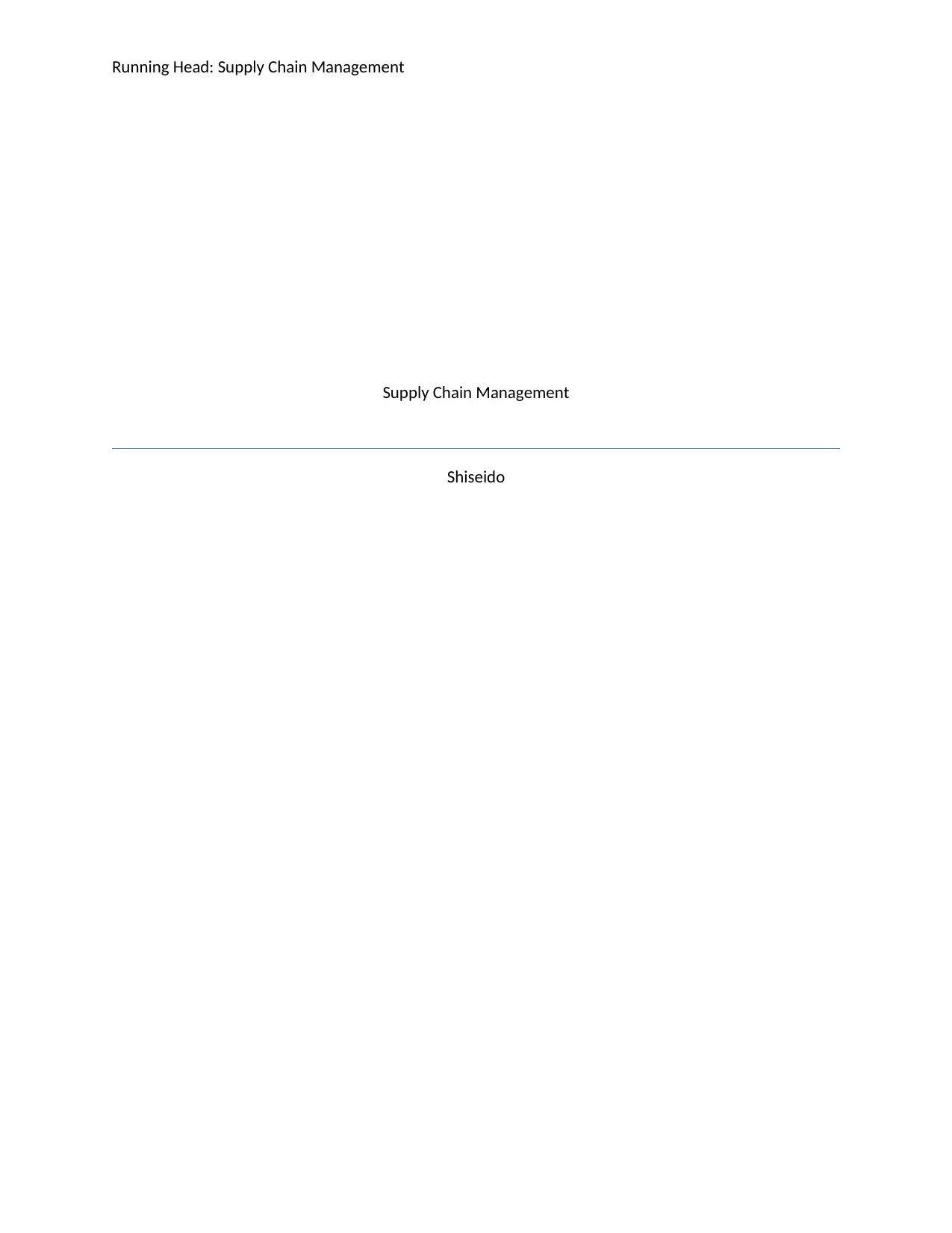
Running Head: Supply Chain Management
Supply Chain Management
Shiseido
Supply Chain Management
Shiseido
Paraphrase This Document
Need a fresh take? Get an instant paraphrase of this document with our AI Paraphraser
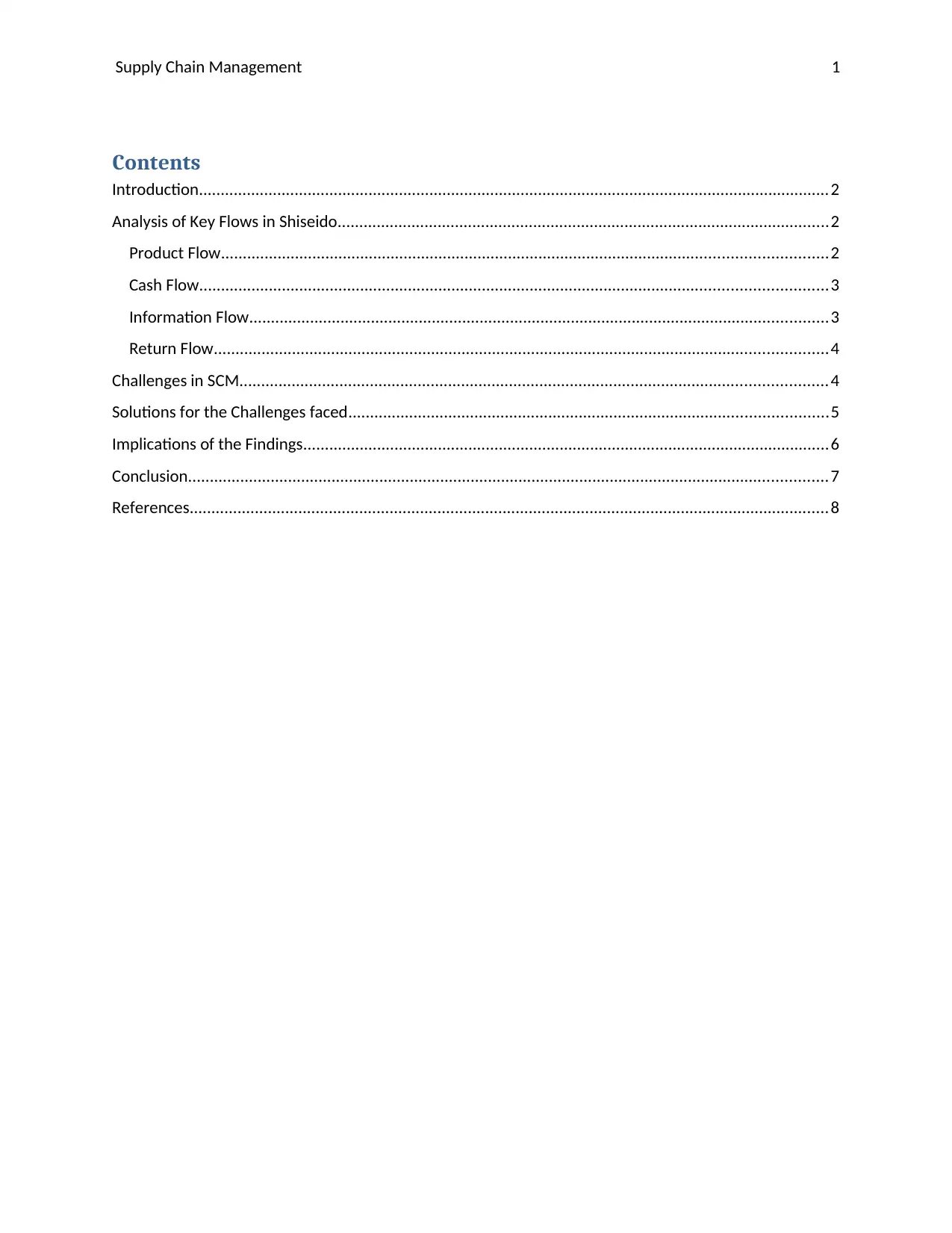
Supply Chain Management 1
Contents
Introduction.................................................................................................................................................2
Analysis of Key Flows in Shiseido.................................................................................................................2
Product Flow...........................................................................................................................................2
Cash Flow................................................................................................................................................3
Information Flow.....................................................................................................................................3
Return Flow.............................................................................................................................................4
Challenges in SCM.......................................................................................................................................4
Solutions for the Challenges faced..............................................................................................................5
Implications of the Findings.........................................................................................................................6
Conclusion...................................................................................................................................................7
References...................................................................................................................................................8
Contents
Introduction.................................................................................................................................................2
Analysis of Key Flows in Shiseido.................................................................................................................2
Product Flow...........................................................................................................................................2
Cash Flow................................................................................................................................................3
Information Flow.....................................................................................................................................3
Return Flow.............................................................................................................................................4
Challenges in SCM.......................................................................................................................................4
Solutions for the Challenges faced..............................................................................................................5
Implications of the Findings.........................................................................................................................6
Conclusion...................................................................................................................................................7
References...................................................................................................................................................8
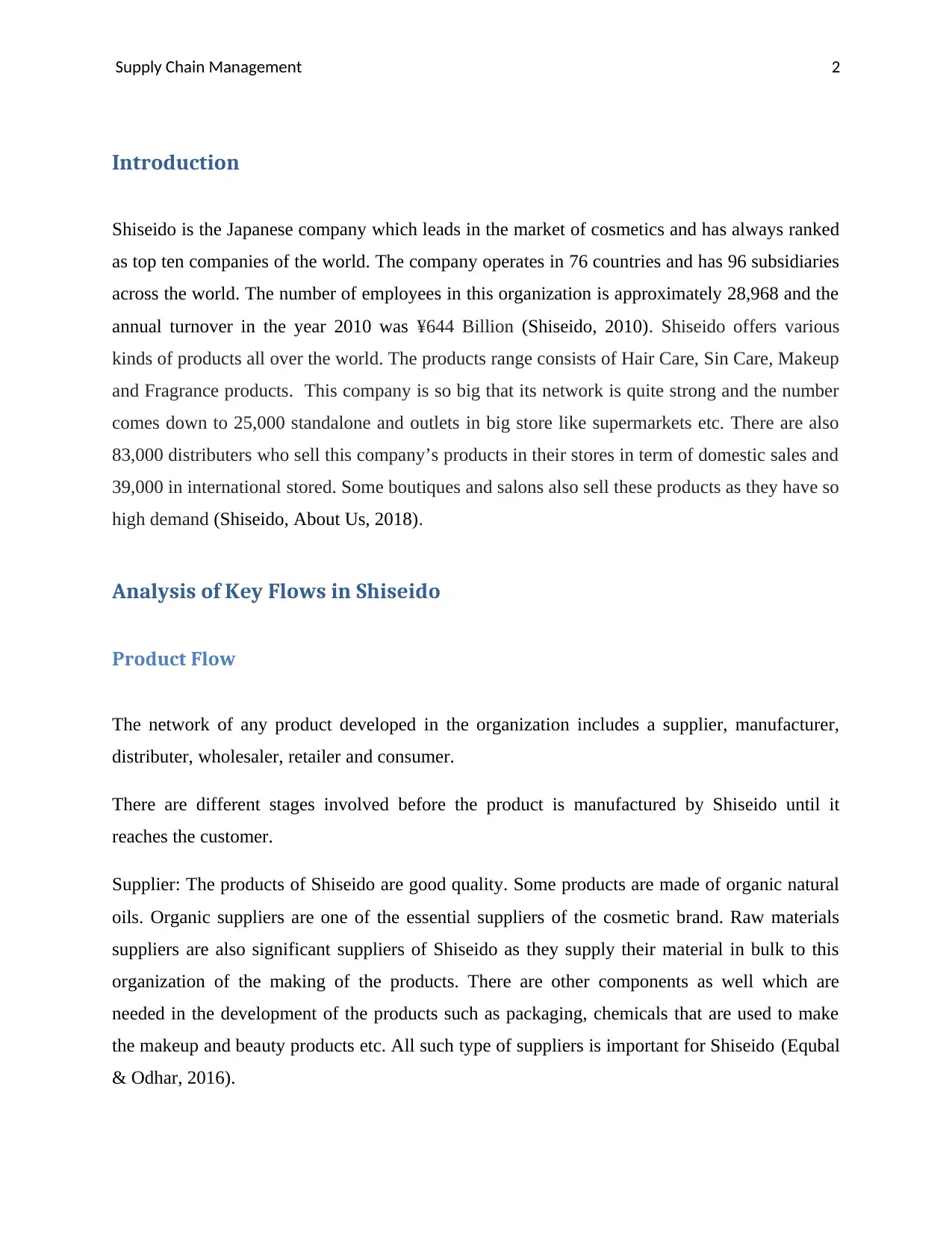
Supply Chain Management 2
Introduction
Shiseido is the Japanese company which leads in the market of cosmetics and has always ranked
as top ten companies of the world. The company operates in 76 countries and has 96 subsidiaries
across the world. The number of employees in this organization is approximately 28,968 and the
annual turnover in the year 2010 was ¥644 Billion (Shiseido, 2010). Shiseido offers various
kinds of products all over the world. The products range consists of Hair Care, Sin Care, Makeup
and Fragrance products. This company is so big that its network is quite strong and the number
comes down to 25,000 standalone and outlets in big store like supermarkets etc. There are also
83,000 distributers who sell this company’s products in their stores in term of domestic sales and
39,000 in international stored. Some boutiques and salons also sell these products as they have so
high demand (Shiseido, About Us, 2018).
Analysis of Key Flows in Shiseido
Product Flow
The network of any product developed in the organization includes a supplier, manufacturer,
distributer, wholesaler, retailer and consumer.
There are different stages involved before the product is manufactured by Shiseido until it
reaches the customer.
Supplier: The products of Shiseido are good quality. Some products are made of organic natural
oils. Organic suppliers are one of the essential suppliers of the cosmetic brand. Raw materials
suppliers are also significant suppliers of Shiseido as they supply their material in bulk to this
organization of the making of the products. There are other components as well which are
needed in the development of the products such as packaging, chemicals that are used to make
the makeup and beauty products etc. All such type of suppliers is important for Shiseido (Equbal
& Odhar, 2016).
Introduction
Shiseido is the Japanese company which leads in the market of cosmetics and has always ranked
as top ten companies of the world. The company operates in 76 countries and has 96 subsidiaries
across the world. The number of employees in this organization is approximately 28,968 and the
annual turnover in the year 2010 was ¥644 Billion (Shiseido, 2010). Shiseido offers various
kinds of products all over the world. The products range consists of Hair Care, Sin Care, Makeup
and Fragrance products. This company is so big that its network is quite strong and the number
comes down to 25,000 standalone and outlets in big store like supermarkets etc. There are also
83,000 distributers who sell this company’s products in their stores in term of domestic sales and
39,000 in international stored. Some boutiques and salons also sell these products as they have so
high demand (Shiseido, About Us, 2018).
Analysis of Key Flows in Shiseido
Product Flow
The network of any product developed in the organization includes a supplier, manufacturer,
distributer, wholesaler, retailer and consumer.
There are different stages involved before the product is manufactured by Shiseido until it
reaches the customer.
Supplier: The products of Shiseido are good quality. Some products are made of organic natural
oils. Organic suppliers are one of the essential suppliers of the cosmetic brand. Raw materials
suppliers are also significant suppliers of Shiseido as they supply their material in bulk to this
organization of the making of the products. There are other components as well which are
needed in the development of the products such as packaging, chemicals that are used to make
the makeup and beauty products etc. All such type of suppliers is important for Shiseido (Equbal
& Odhar, 2016).
⊘ This is a preview!⊘
Do you want full access?
Subscribe today to unlock all pages.

Trusted by 1+ million students worldwide
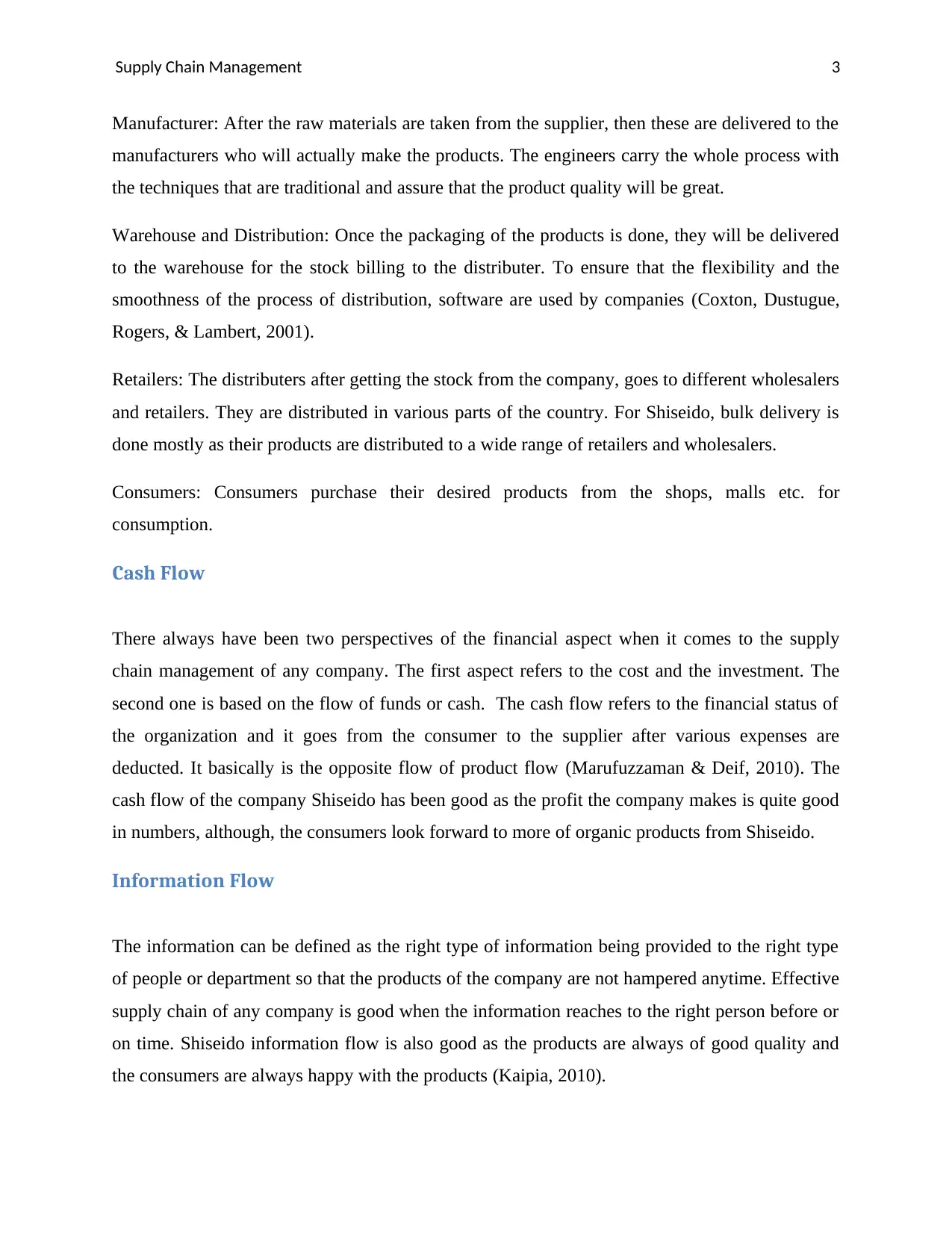
Supply Chain Management 3
Manufacturer: After the raw materials are taken from the supplier, then these are delivered to the
manufacturers who will actually make the products. The engineers carry the whole process with
the techniques that are traditional and assure that the product quality will be great.
Warehouse and Distribution: Once the packaging of the products is done, they will be delivered
to the warehouse for the stock billing to the distributer. To ensure that the flexibility and the
smoothness of the process of distribution, software are used by companies (Coxton, Dustugue,
Rogers, & Lambert, 2001).
Retailers: The distributers after getting the stock from the company, goes to different wholesalers
and retailers. They are distributed in various parts of the country. For Shiseido, bulk delivery is
done mostly as their products are distributed to a wide range of retailers and wholesalers.
Consumers: Consumers purchase their desired products from the shops, malls etc. for
consumption.
Cash Flow
There always have been two perspectives of the financial aspect when it comes to the supply
chain management of any company. The first aspect refers to the cost and the investment. The
second one is based on the flow of funds or cash. The cash flow refers to the financial status of
the organization and it goes from the consumer to the supplier after various expenses are
deducted. It basically is the opposite flow of product flow (Marufuzzaman & Deif, 2010). The
cash flow of the company Shiseido has been good as the profit the company makes is quite good
in numbers, although, the consumers look forward to more of organic products from Shiseido.
Information Flow
The information can be defined as the right type of information being provided to the right type
of people or department so that the products of the company are not hampered anytime. Effective
supply chain of any company is good when the information reaches to the right person before or
on time. Shiseido information flow is also good as the products are always of good quality and
the consumers are always happy with the products (Kaipia, 2010).
Manufacturer: After the raw materials are taken from the supplier, then these are delivered to the
manufacturers who will actually make the products. The engineers carry the whole process with
the techniques that are traditional and assure that the product quality will be great.
Warehouse and Distribution: Once the packaging of the products is done, they will be delivered
to the warehouse for the stock billing to the distributer. To ensure that the flexibility and the
smoothness of the process of distribution, software are used by companies (Coxton, Dustugue,
Rogers, & Lambert, 2001).
Retailers: The distributers after getting the stock from the company, goes to different wholesalers
and retailers. They are distributed in various parts of the country. For Shiseido, bulk delivery is
done mostly as their products are distributed to a wide range of retailers and wholesalers.
Consumers: Consumers purchase their desired products from the shops, malls etc. for
consumption.
Cash Flow
There always have been two perspectives of the financial aspect when it comes to the supply
chain management of any company. The first aspect refers to the cost and the investment. The
second one is based on the flow of funds or cash. The cash flow refers to the financial status of
the organization and it goes from the consumer to the supplier after various expenses are
deducted. It basically is the opposite flow of product flow (Marufuzzaman & Deif, 2010). The
cash flow of the company Shiseido has been good as the profit the company makes is quite good
in numbers, although, the consumers look forward to more of organic products from Shiseido.
Information Flow
The information can be defined as the right type of information being provided to the right type
of people or department so that the products of the company are not hampered anytime. Effective
supply chain of any company is good when the information reaches to the right person before or
on time. Shiseido information flow is also good as the products are always of good quality and
the consumers are always happy with the products (Kaipia, 2010).
Paraphrase This Document
Need a fresh take? Get an instant paraphrase of this document with our AI Paraphraser
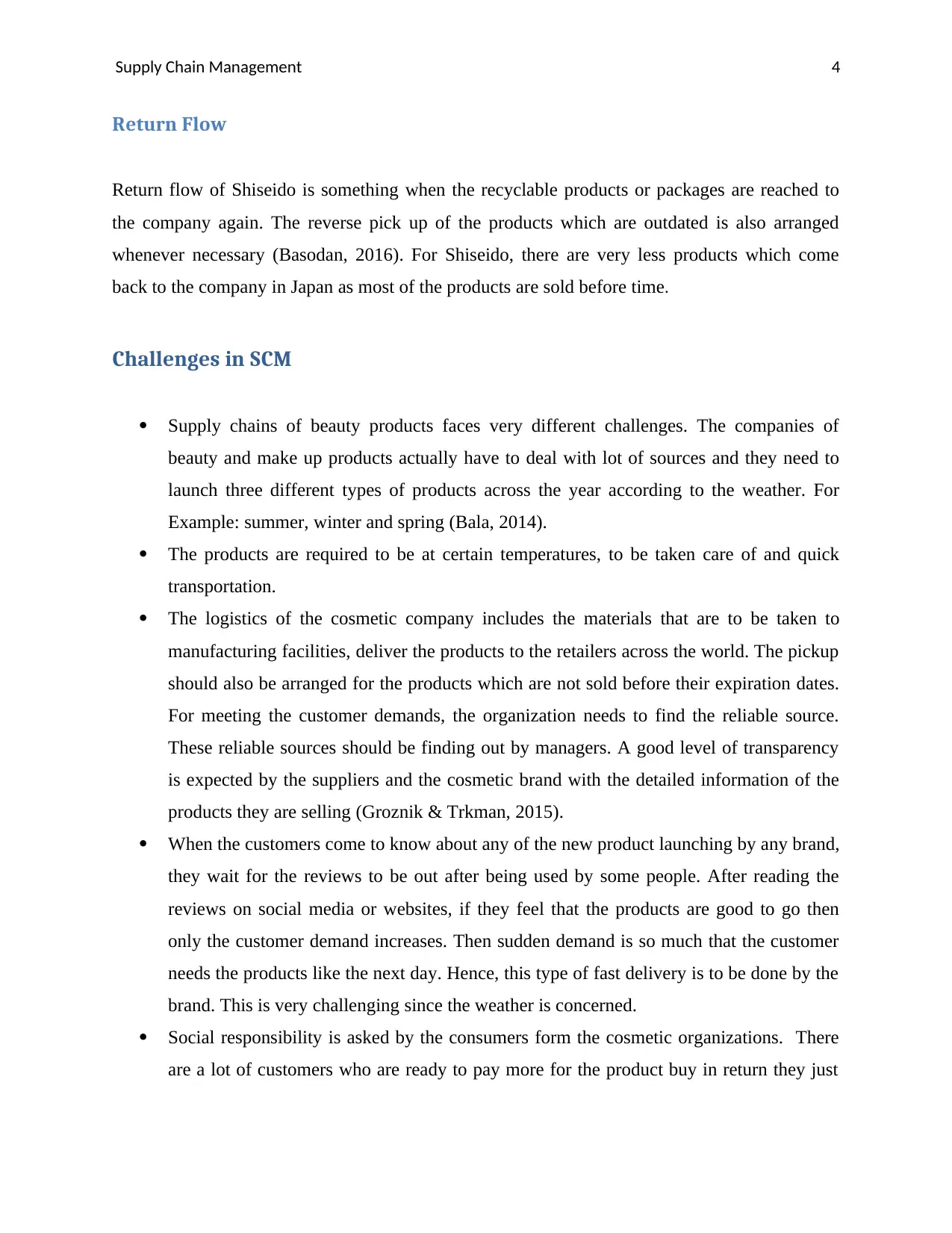
Supply Chain Management 4
Return Flow
Return flow of Shiseido is something when the recyclable products or packages are reached to
the company again. The reverse pick up of the products which are outdated is also arranged
whenever necessary (Basodan, 2016). For Shiseido, there are very less products which come
back to the company in Japan as most of the products are sold before time.
Challenges in SCM
Supply chains of beauty products faces very different challenges. The companies of
beauty and make up products actually have to deal with lot of sources and they need to
launch three different types of products across the year according to the weather. For
Example: summer, winter and spring (Bala, 2014).
The products are required to be at certain temperatures, to be taken care of and quick
transportation.
The logistics of the cosmetic company includes the materials that are to be taken to
manufacturing facilities, deliver the products to the retailers across the world. The pickup
should also be arranged for the products which are not sold before their expiration dates.
For meeting the customer demands, the organization needs to find the reliable source.
These reliable sources should be finding out by managers. A good level of transparency
is expected by the suppliers and the cosmetic brand with the detailed information of the
products they are selling (Groznik & Trkman, 2015).
When the customers come to know about any of the new product launching by any brand,
they wait for the reviews to be out after being used by some people. After reading the
reviews on social media or websites, if they feel that the products are good to go then
only the customer demand increases. Then sudden demand is so much that the customer
needs the products like the next day. Hence, this type of fast delivery is to be done by the
brand. This is very challenging since the weather is concerned.
Social responsibility is asked by the consumers form the cosmetic organizations. There
are a lot of customers who are ready to pay more for the product buy in return they just
Return Flow
Return flow of Shiseido is something when the recyclable products or packages are reached to
the company again. The reverse pick up of the products which are outdated is also arranged
whenever necessary (Basodan, 2016). For Shiseido, there are very less products which come
back to the company in Japan as most of the products are sold before time.
Challenges in SCM
Supply chains of beauty products faces very different challenges. The companies of
beauty and make up products actually have to deal with lot of sources and they need to
launch three different types of products across the year according to the weather. For
Example: summer, winter and spring (Bala, 2014).
The products are required to be at certain temperatures, to be taken care of and quick
transportation.
The logistics of the cosmetic company includes the materials that are to be taken to
manufacturing facilities, deliver the products to the retailers across the world. The pickup
should also be arranged for the products which are not sold before their expiration dates.
For meeting the customer demands, the organization needs to find the reliable source.
These reliable sources should be finding out by managers. A good level of transparency
is expected by the suppliers and the cosmetic brand with the detailed information of the
products they are selling (Groznik & Trkman, 2015).
When the customers come to know about any of the new product launching by any brand,
they wait for the reviews to be out after being used by some people. After reading the
reviews on social media or websites, if they feel that the products are good to go then
only the customer demand increases. Then sudden demand is so much that the customer
needs the products like the next day. Hence, this type of fast delivery is to be done by the
brand. This is very challenging since the weather is concerned.
Social responsibility is asked by the consumers form the cosmetic organizations. There
are a lot of customers who are ready to pay more for the product buy in return they just
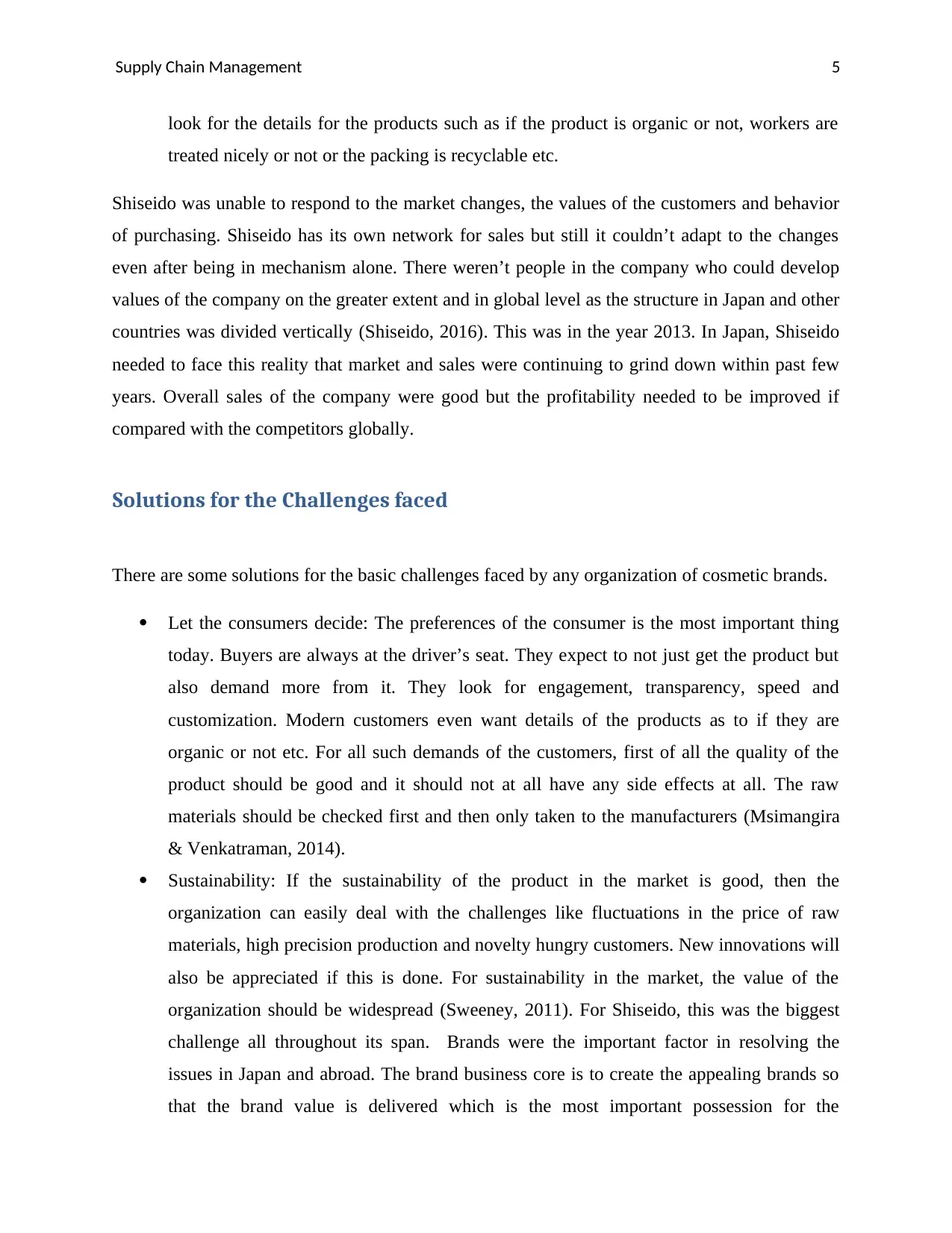
Supply Chain Management 5
look for the details for the products such as if the product is organic or not, workers are
treated nicely or not or the packing is recyclable etc.
Shiseido was unable to respond to the market changes, the values of the customers and behavior
of purchasing. Shiseido has its own network for sales but still it couldn’t adapt to the changes
even after being in mechanism alone. There weren’t people in the company who could develop
values of the company on the greater extent and in global level as the structure in Japan and other
countries was divided vertically (Shiseido, 2016). This was in the year 2013. In Japan, Shiseido
needed to face this reality that market and sales were continuing to grind down within past few
years. Overall sales of the company were good but the profitability needed to be improved if
compared with the competitors globally.
Solutions for the Challenges faced
There are some solutions for the basic challenges faced by any organization of cosmetic brands.
Let the consumers decide: The preferences of the consumer is the most important thing
today. Buyers are always at the driver’s seat. They expect to not just get the product but
also demand more from it. They look for engagement, transparency, speed and
customization. Modern customers even want details of the products as to if they are
organic or not etc. For all such demands of the customers, first of all the quality of the
product should be good and it should not at all have any side effects at all. The raw
materials should be checked first and then only taken to the manufacturers (Msimangira
& Venkatraman, 2014).
Sustainability: If the sustainability of the product in the market is good, then the
organization can easily deal with the challenges like fluctuations in the price of raw
materials, high precision production and novelty hungry customers. New innovations will
also be appreciated if this is done. For sustainability in the market, the value of the
organization should be widespread (Sweeney, 2011). For Shiseido, this was the biggest
challenge all throughout its span. Brands were the important factor in resolving the
issues in Japan and abroad. The brand business core is to create the appealing brands so
that the brand value is delivered which is the most important possession for the
look for the details for the products such as if the product is organic or not, workers are
treated nicely or not or the packing is recyclable etc.
Shiseido was unable to respond to the market changes, the values of the customers and behavior
of purchasing. Shiseido has its own network for sales but still it couldn’t adapt to the changes
even after being in mechanism alone. There weren’t people in the company who could develop
values of the company on the greater extent and in global level as the structure in Japan and other
countries was divided vertically (Shiseido, 2016). This was in the year 2013. In Japan, Shiseido
needed to face this reality that market and sales were continuing to grind down within past few
years. Overall sales of the company were good but the profitability needed to be improved if
compared with the competitors globally.
Solutions for the Challenges faced
There are some solutions for the basic challenges faced by any organization of cosmetic brands.
Let the consumers decide: The preferences of the consumer is the most important thing
today. Buyers are always at the driver’s seat. They expect to not just get the product but
also demand more from it. They look for engagement, transparency, speed and
customization. Modern customers even want details of the products as to if they are
organic or not etc. For all such demands of the customers, first of all the quality of the
product should be good and it should not at all have any side effects at all. The raw
materials should be checked first and then only taken to the manufacturers (Msimangira
& Venkatraman, 2014).
Sustainability: If the sustainability of the product in the market is good, then the
organization can easily deal with the challenges like fluctuations in the price of raw
materials, high precision production and novelty hungry customers. New innovations will
also be appreciated if this is done. For sustainability in the market, the value of the
organization should be widespread (Sweeney, 2011). For Shiseido, this was the biggest
challenge all throughout its span. Brands were the important factor in resolving the
issues in Japan and abroad. The brand business core is to create the appealing brands so
that the brand value is delivered which is the most important possession for the
⊘ This is a preview!⊘
Do you want full access?
Subscribe today to unlock all pages.

Trusted by 1+ million students worldwide
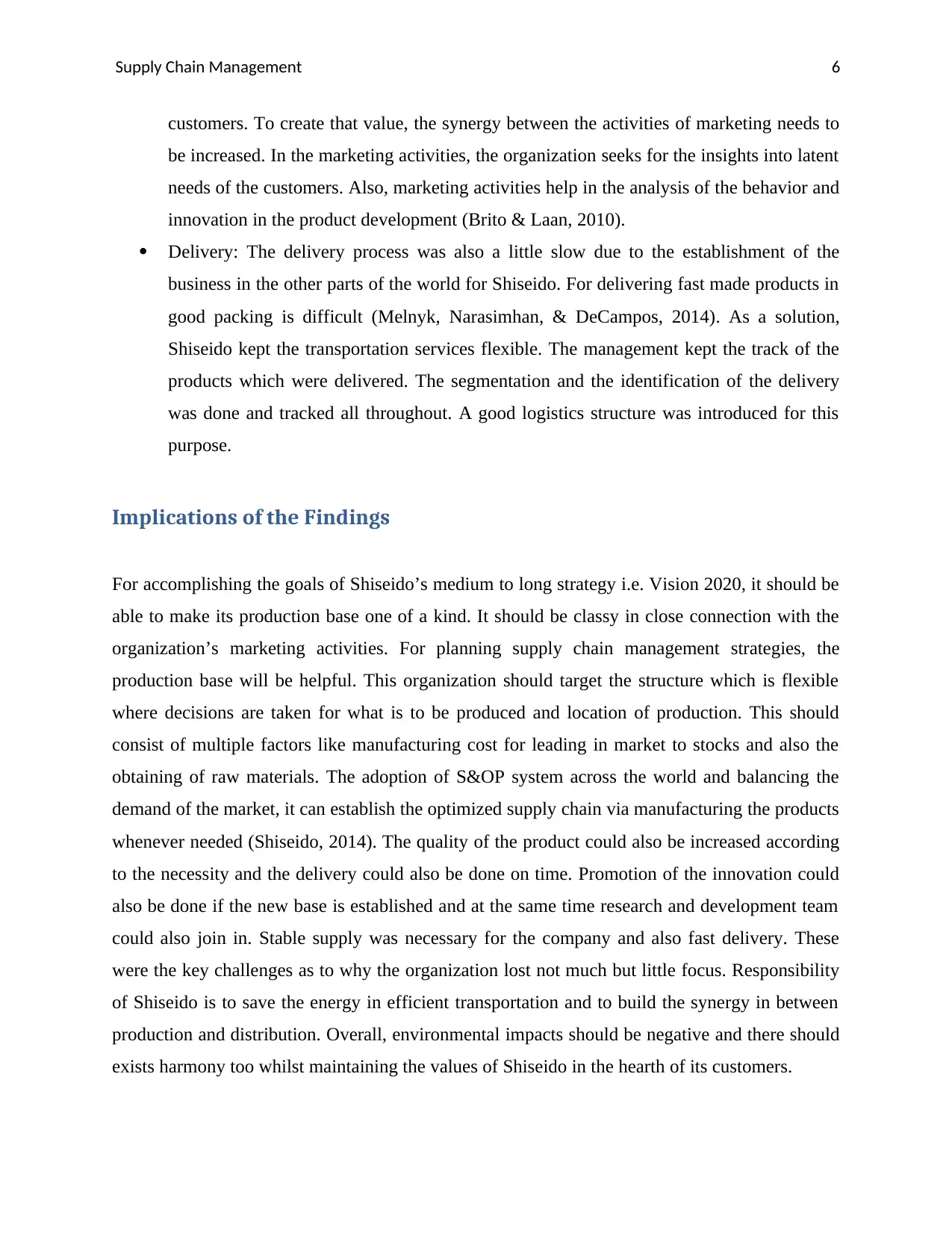
Supply Chain Management 6
customers. To create that value, the synergy between the activities of marketing needs to
be increased. In the marketing activities, the organization seeks for the insights into latent
needs of the customers. Also, marketing activities help in the analysis of the behavior and
innovation in the product development (Brito & Laan, 2010).
Delivery: The delivery process was also a little slow due to the establishment of the
business in the other parts of the world for Shiseido. For delivering fast made products in
good packing is difficult (Melnyk, Narasimhan, & DeCampos, 2014). As a solution,
Shiseido kept the transportation services flexible. The management kept the track of the
products which were delivered. The segmentation and the identification of the delivery
was done and tracked all throughout. A good logistics structure was introduced for this
purpose.
Implications of the Findings
For accomplishing the goals of Shiseido’s medium to long strategy i.e. Vision 2020, it should be
able to make its production base one of a kind. It should be classy in close connection with the
organization’s marketing activities. For planning supply chain management strategies, the
production base will be helpful. This organization should target the structure which is flexible
where decisions are taken for what is to be produced and location of production. This should
consist of multiple factors like manufacturing cost for leading in market to stocks and also the
obtaining of raw materials. The adoption of S&OP system across the world and balancing the
demand of the market, it can establish the optimized supply chain via manufacturing the products
whenever needed (Shiseido, 2014). The quality of the product could also be increased according
to the necessity and the delivery could also be done on time. Promotion of the innovation could
also be done if the new base is established and at the same time research and development team
could also join in. Stable supply was necessary for the company and also fast delivery. These
were the key challenges as to why the organization lost not much but little focus. Responsibility
of Shiseido is to save the energy in efficient transportation and to build the synergy in between
production and distribution. Overall, environmental impacts should be negative and there should
exists harmony too whilst maintaining the values of Shiseido in the hearth of its customers.
customers. To create that value, the synergy between the activities of marketing needs to
be increased. In the marketing activities, the organization seeks for the insights into latent
needs of the customers. Also, marketing activities help in the analysis of the behavior and
innovation in the product development (Brito & Laan, 2010).
Delivery: The delivery process was also a little slow due to the establishment of the
business in the other parts of the world for Shiseido. For delivering fast made products in
good packing is difficult (Melnyk, Narasimhan, & DeCampos, 2014). As a solution,
Shiseido kept the transportation services flexible. The management kept the track of the
products which were delivered. The segmentation and the identification of the delivery
was done and tracked all throughout. A good logistics structure was introduced for this
purpose.
Implications of the Findings
For accomplishing the goals of Shiseido’s medium to long strategy i.e. Vision 2020, it should be
able to make its production base one of a kind. It should be classy in close connection with the
organization’s marketing activities. For planning supply chain management strategies, the
production base will be helpful. This organization should target the structure which is flexible
where decisions are taken for what is to be produced and location of production. This should
consist of multiple factors like manufacturing cost for leading in market to stocks and also the
obtaining of raw materials. The adoption of S&OP system across the world and balancing the
demand of the market, it can establish the optimized supply chain via manufacturing the products
whenever needed (Shiseido, 2014). The quality of the product could also be increased according
to the necessity and the delivery could also be done on time. Promotion of the innovation could
also be done if the new base is established and at the same time research and development team
could also join in. Stable supply was necessary for the company and also fast delivery. These
were the key challenges as to why the organization lost not much but little focus. Responsibility
of Shiseido is to save the energy in efficient transportation and to build the synergy in between
production and distribution. Overall, environmental impacts should be negative and there should
exists harmony too whilst maintaining the values of Shiseido in the hearth of its customers.
Paraphrase This Document
Need a fresh take? Get an instant paraphrase of this document with our AI Paraphraser
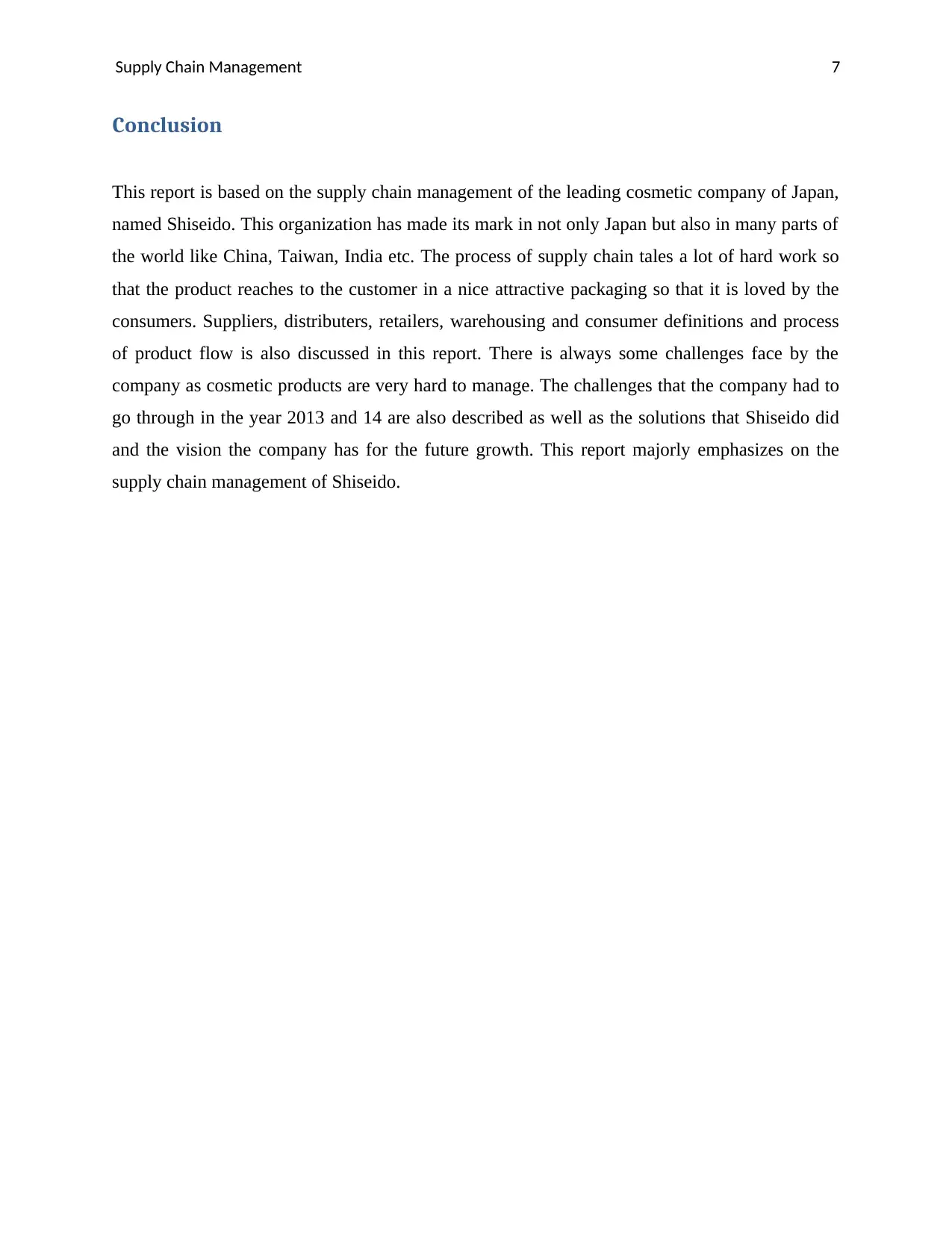
Supply Chain Management 7
Conclusion
This report is based on the supply chain management of the leading cosmetic company of Japan,
named Shiseido. This organization has made its mark in not only Japan but also in many parts of
the world like China, Taiwan, India etc. The process of supply chain tales a lot of hard work so
that the product reaches to the customer in a nice attractive packaging so that it is loved by the
consumers. Suppliers, distributers, retailers, warehousing and consumer definitions and process
of product flow is also discussed in this report. There is always some challenges face by the
company as cosmetic products are very hard to manage. The challenges that the company had to
go through in the year 2013 and 14 are also described as well as the solutions that Shiseido did
and the vision the company has for the future growth. This report majorly emphasizes on the
supply chain management of Shiseido.
Conclusion
This report is based on the supply chain management of the leading cosmetic company of Japan,
named Shiseido. This organization has made its mark in not only Japan but also in many parts of
the world like China, Taiwan, India etc. The process of supply chain tales a lot of hard work so
that the product reaches to the customer in a nice attractive packaging so that it is loved by the
consumers. Suppliers, distributers, retailers, warehousing and consumer definitions and process
of product flow is also discussed in this report. There is always some challenges face by the
company as cosmetic products are very hard to manage. The challenges that the company had to
go through in the year 2013 and 14 are also described as well as the solutions that Shiseido did
and the vision the company has for the future growth. This report majorly emphasizes on the
supply chain management of Shiseido.
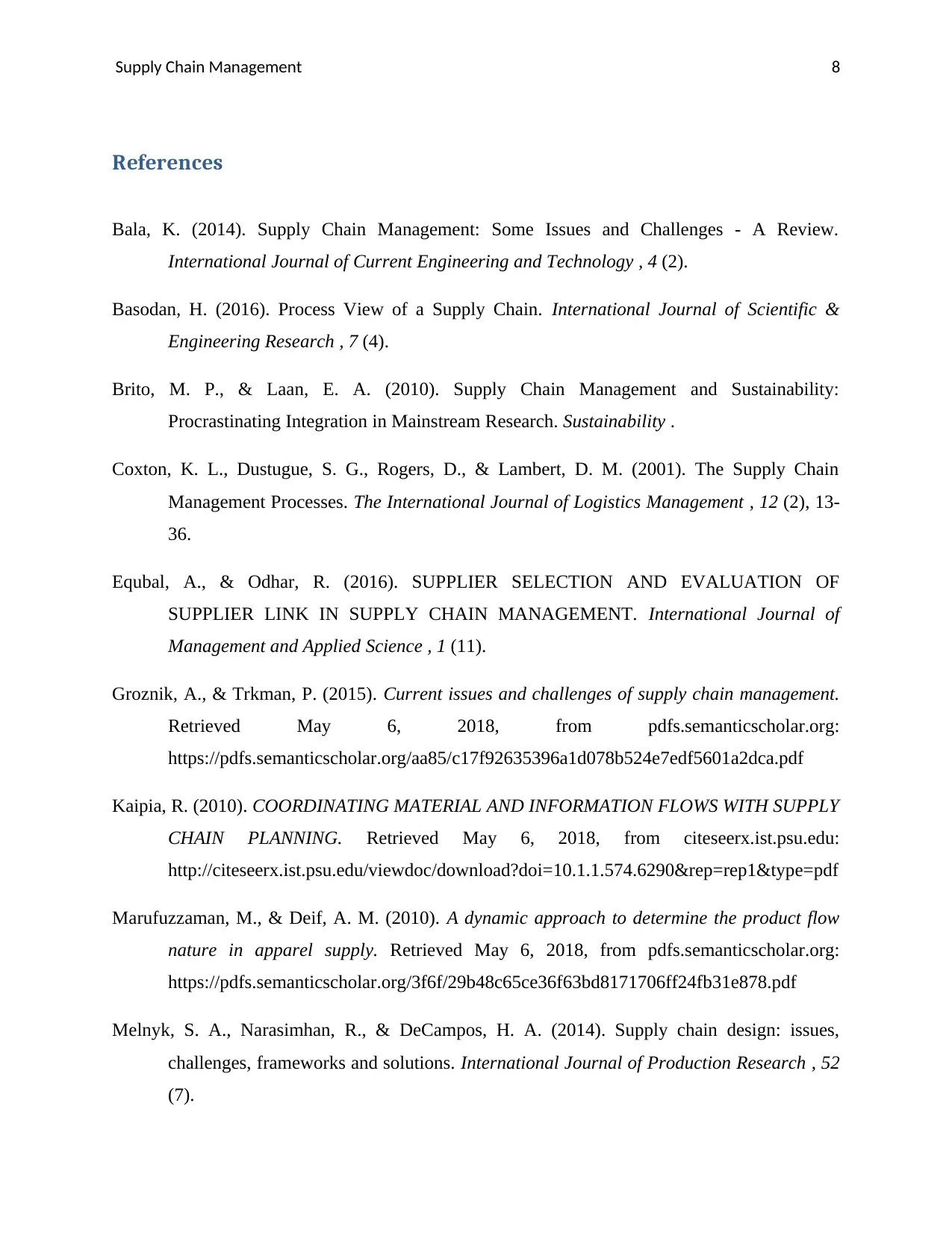
Supply Chain Management 8
References
Bala, K. (2014). Supply Chain Management: Some Issues and Challenges - A Review.
International Journal of Current Engineering and Technology , 4 (2).
Basodan, H. (2016). Process View of a Supply Chain. International Journal of Scientific &
Engineering Research , 7 (4).
Brito, M. P., & Laan, E. A. (2010). Supply Chain Management and Sustainability:
Procrastinating Integration in Mainstream Research. Sustainability .
Coxton, K. L., Dustugue, S. G., Rogers, D., & Lambert, D. M. (2001). The Supply Chain
Management Processes. The International Journal of Logistics Management , 12 (2), 13-
36.
Equbal, A., & Odhar, R. (2016). SUPPLIER SELECTION AND EVALUATION OF
SUPPLIER LINK IN SUPPLY CHAIN MANAGEMENT. International Journal of
Management and Applied Science , 1 (11).
Groznik, A., & Trkman, P. (2015). Current issues and challenges of supply chain management.
Retrieved May 6, 2018, from pdfs.semanticscholar.org:
https://pdfs.semanticscholar.org/aa85/c17f92635396a1d078b524e7edf5601a2dca.pdf
Kaipia, R. (2010). COORDINATING MATERIAL AND INFORMATION FLOWS WITH SUPPLY
CHAIN PLANNING. Retrieved May 6, 2018, from citeseerx.ist.psu.edu:
http://citeseerx.ist.psu.edu/viewdoc/download?doi=10.1.1.574.6290&rep=rep1&type=pdf
Marufuzzaman, M., & Deif, A. M. (2010). A dynamic approach to determine the product flow
nature in apparel supply. Retrieved May 6, 2018, from pdfs.semanticscholar.org:
https://pdfs.semanticscholar.org/3f6f/29b48c65ce36f63bd8171706ff24fb31e878.pdf
Melnyk, S. A., Narasimhan, R., & DeCampos, H. A. (2014). Supply chain design: issues,
challenges, frameworks and solutions. International Journal of Production Research , 52
(7).
References
Bala, K. (2014). Supply Chain Management: Some Issues and Challenges - A Review.
International Journal of Current Engineering and Technology , 4 (2).
Basodan, H. (2016). Process View of a Supply Chain. International Journal of Scientific &
Engineering Research , 7 (4).
Brito, M. P., & Laan, E. A. (2010). Supply Chain Management and Sustainability:
Procrastinating Integration in Mainstream Research. Sustainability .
Coxton, K. L., Dustugue, S. G., Rogers, D., & Lambert, D. M. (2001). The Supply Chain
Management Processes. The International Journal of Logistics Management , 12 (2), 13-
36.
Equbal, A., & Odhar, R. (2016). SUPPLIER SELECTION AND EVALUATION OF
SUPPLIER LINK IN SUPPLY CHAIN MANAGEMENT. International Journal of
Management and Applied Science , 1 (11).
Groznik, A., & Trkman, P. (2015). Current issues and challenges of supply chain management.
Retrieved May 6, 2018, from pdfs.semanticscholar.org:
https://pdfs.semanticscholar.org/aa85/c17f92635396a1d078b524e7edf5601a2dca.pdf
Kaipia, R. (2010). COORDINATING MATERIAL AND INFORMATION FLOWS WITH SUPPLY
CHAIN PLANNING. Retrieved May 6, 2018, from citeseerx.ist.psu.edu:
http://citeseerx.ist.psu.edu/viewdoc/download?doi=10.1.1.574.6290&rep=rep1&type=pdf
Marufuzzaman, M., & Deif, A. M. (2010). A dynamic approach to determine the product flow
nature in apparel supply. Retrieved May 6, 2018, from pdfs.semanticscholar.org:
https://pdfs.semanticscholar.org/3f6f/29b48c65ce36f63bd8171706ff24fb31e878.pdf
Melnyk, S. A., Narasimhan, R., & DeCampos, H. A. (2014). Supply chain design: issues,
challenges, frameworks and solutions. International Journal of Production Research , 52
(7).
⊘ This is a preview!⊘
Do you want full access?
Subscribe today to unlock all pages.

Trusted by 1+ million students worldwide
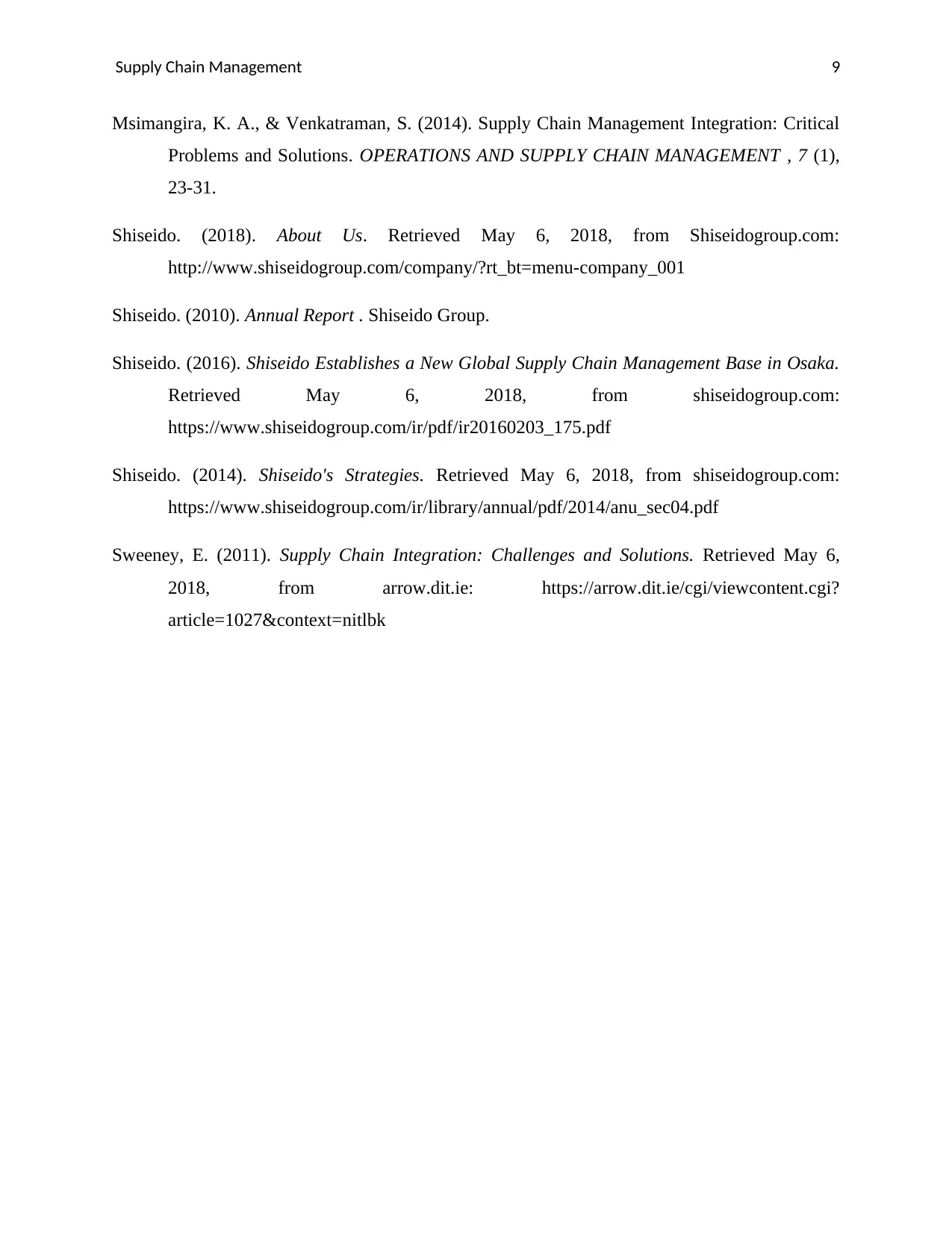
Supply Chain Management 9
Msimangira, K. A., & Venkatraman, S. (2014). Supply Chain Management Integration: Critical
Problems and Solutions. OPERATIONS AND SUPPLY CHAIN MANAGEMENT , 7 (1),
23-31.
Shiseido. (2018). About Us. Retrieved May 6, 2018, from Shiseidogroup.com:
http://www.shiseidogroup.com/company/?rt_bt=menu-company_001
Shiseido. (2010). Annual Report . Shiseido Group.
Shiseido. (2016). Shiseido Establishes a New Global Supply Chain Management Base in Osaka.
Retrieved May 6, 2018, from shiseidogroup.com:
https://www.shiseidogroup.com/ir/pdf/ir20160203_175.pdf
Shiseido. (2014). Shiseido's Strategies. Retrieved May 6, 2018, from shiseidogroup.com:
https://www.shiseidogroup.com/ir/library/annual/pdf/2014/anu_sec04.pdf
Sweeney, E. (2011). Supply Chain Integration: Challenges and Solutions. Retrieved May 6,
2018, from arrow.dit.ie: https://arrow.dit.ie/cgi/viewcontent.cgi?
article=1027&context=nitlbk
Msimangira, K. A., & Venkatraman, S. (2014). Supply Chain Management Integration: Critical
Problems and Solutions. OPERATIONS AND SUPPLY CHAIN MANAGEMENT , 7 (1),
23-31.
Shiseido. (2018). About Us. Retrieved May 6, 2018, from Shiseidogroup.com:
http://www.shiseidogroup.com/company/?rt_bt=menu-company_001
Shiseido. (2010). Annual Report . Shiseido Group.
Shiseido. (2016). Shiseido Establishes a New Global Supply Chain Management Base in Osaka.
Retrieved May 6, 2018, from shiseidogroup.com:
https://www.shiseidogroup.com/ir/pdf/ir20160203_175.pdf
Shiseido. (2014). Shiseido's Strategies. Retrieved May 6, 2018, from shiseidogroup.com:
https://www.shiseidogroup.com/ir/library/annual/pdf/2014/anu_sec04.pdf
Sweeney, E. (2011). Supply Chain Integration: Challenges and Solutions. Retrieved May 6,
2018, from arrow.dit.ie: https://arrow.dit.ie/cgi/viewcontent.cgi?
article=1027&context=nitlbk
1 out of 10
Related Documents
Your All-in-One AI-Powered Toolkit for Academic Success.
+13062052269
info@desklib.com
Available 24*7 on WhatsApp / Email
![[object Object]](/_next/static/media/star-bottom.7253800d.svg)
Unlock your academic potential
Copyright © 2020–2025 A2Z Services. All Rights Reserved. Developed and managed by ZUCOL.





